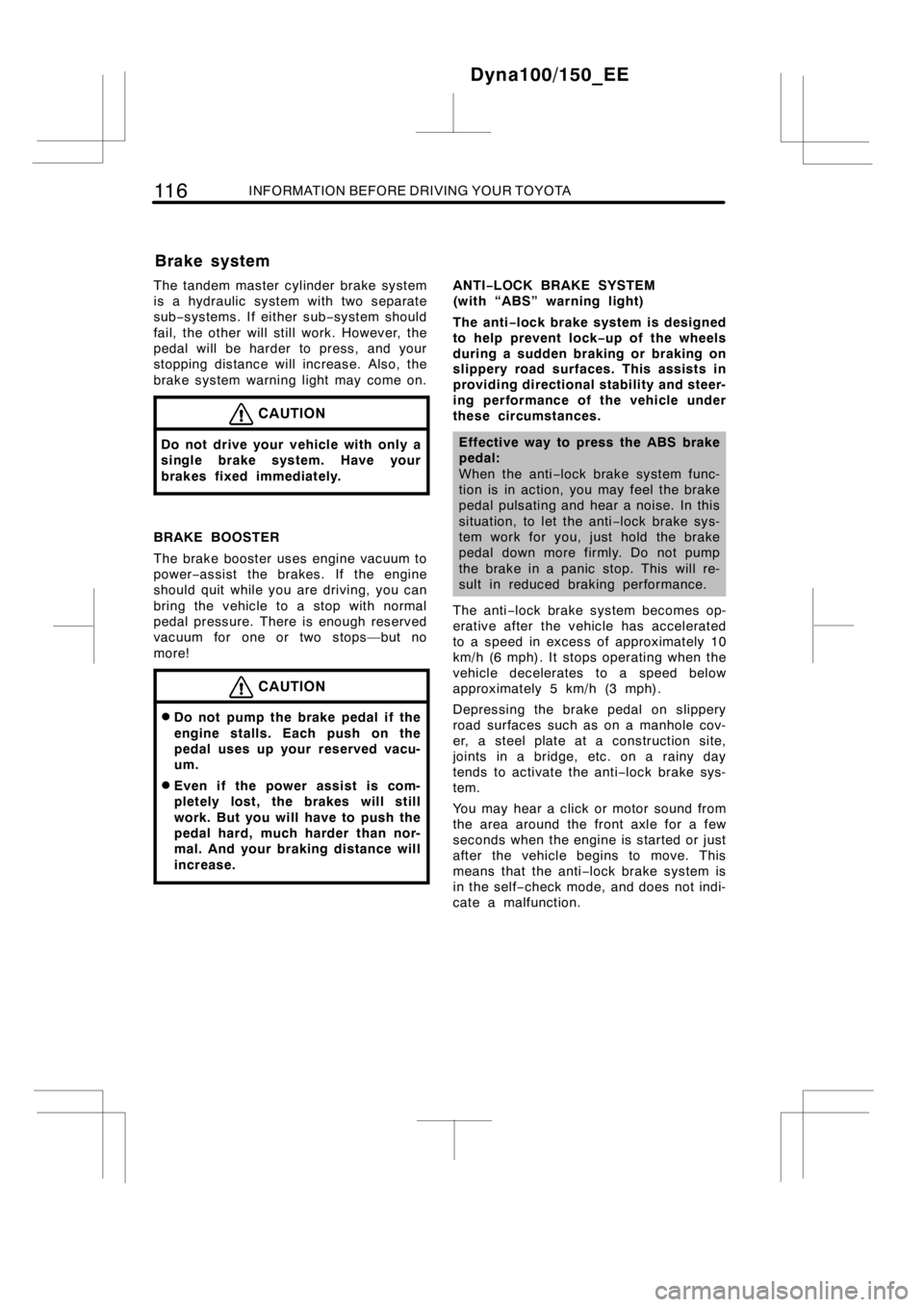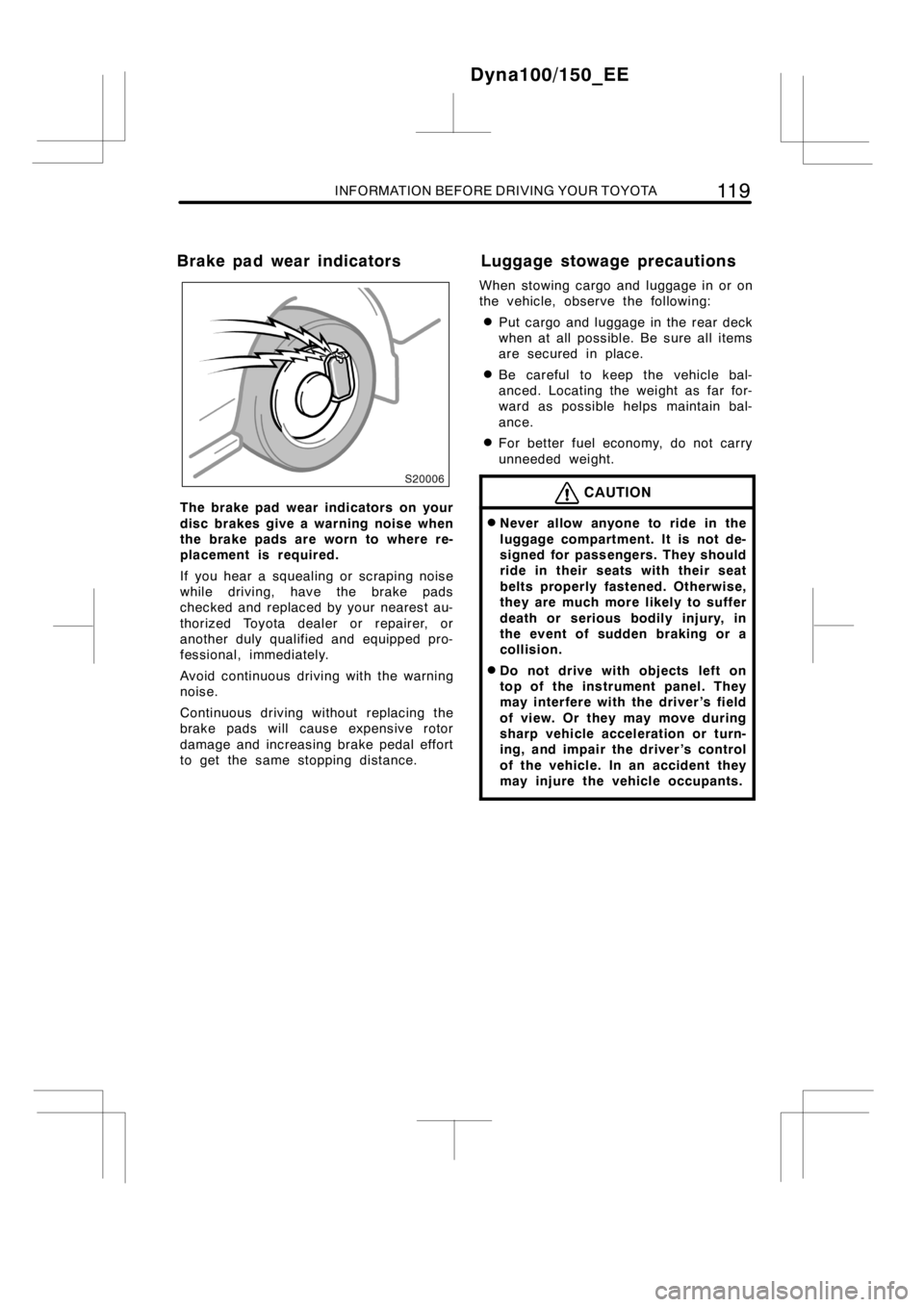2014 TOYOTA DYNA 100/150 brakes
[x] Cancel search: brakesPage 81 of 232

GAUGES, METERS AND SERVICE REMINDER INDICATORS75
(a) Brake System Warning Light
This light comes on in the following cases
when the engine switch is in the “ON”
position.
DWhen the parking brake is applied...
DWhen the brake fluid level is low...
CAUTION
It is dangerous to continue driving
normally when the brake fluid level is
low.
DWhen vacuum is low...
Have your vehicle checked at any
authorized Toyota dealer or repairer, or
another duly qualified and equipped
professional, in the following case:
DThe light does not come on even if the
parking brake is applied when the en-
gine switch is in the “ON” position.
CAUTION
If the light does not turn off even
after the parking brake is released
while the engine is running, immedi-
ately stop your vehicle at a safe
place and contact any authorized
Toyota dealer or repairer, or another
duly qualified and equipped professio-
nal. In this case, the brakes may not
work properly and your stopping
distance will become longer. Depress
the brake pedal firmly and bring the
vehicle to an immediate stop.
(b) Charging System Warning Light
This warning light comes on when the
engine switch is turned to the “ON” posi-
tion, and goes off when the engine is
started.
When there are problems in the charging
system while theengine is running, the
warning light comes on.
NOTICE
When the charging system warning
light comes on while the engine is
running, malfunctions such as the en-
gine drive belt being broken may have
occurred. If the warning light comes
on, immediately stop the vehicle in a
safe place and contact any authorized
Toyota dealer or repairer, or another
duly qualified and equipped profes-
sional.
(c) Low Engine Oil Pressure Warning
Light
This light warns that the engine oil pres-
sure is too low.
If it flickers or stays on while you are
driving, pull off the road to a safe place
and stop the engine immediately. Call any
authorized Toyota dealer or repairer, or
another duly qualified and equipped pro-
fessional, for assistance.
The light may occasionally flicker when
the engine is idling or it may come on
briefly after a hard stop. There is no
cause for concern if it then goes out when
the engine is accelerated slightly.
The light may come on when the oil level
is extremely low. It is not designed to
indicate low oil level, and the oil level
must be checked using the level dipstick.
NOTICE
Do not drive the vehicle with the
warning light on—even for one block.
It may ruin the engine.
(d) Low Engine Oil Level Warning Light
This light warns that the engine oil level
is too low. Add oil as soon as possible.
(For instructions, see “Checking the en-
gine oil level” on page 188 in Section
7−2.)
Dyna100/150_EE
Page 122 of 232

11 6INFORMATION BEFORE DRIVING YOUR TOYOTA
The tandem master cylinder brakesystem
is a hydraulic system with two separate
sub−systems. If either sub−system should
fail, the other will still work. However, the
pedal will be harder to press, and your
stopping distance will increase. Also, the
brake system warning light may come on.
CAUTION
Do not drive your vehicle with only a
single brake system. Have your
brakes fixed immediately.
BRAKE BOOSTER
The brake booster uses engine vacuum to
power−assist the brakes. If the engine
should quit while you are driving, you can
bringthevehicletoastopwithnormal
pedal pressure. There is enough reserved
vacuum for one or two stops—but no
more!
CAUTION
DDo not pump the brake pedal if the
engine stalls. Each push on the
pedal uses up your reserved vacu-
um.
DEven if the power assist is com-
pletely lost, the brakes will still
work. But you will have to push the
pedal hard, much harder than nor-
mal. And your braking distance will
increase.
ANTI−LOCK BRAKE SYSTEM
(with “ABS” warning light)
The anti−lock brake system is designed
to help prevent lock−up of the wheels
during a sudden braking or braking on
slippery road surfaces. This assists in
providing directional stability and steer-
ing performance of the vehicle under
these circumstances.
Effective way to press the ABS brake
pedal:
When the anti−lock brake system func-
tion is in action, you may feel the brake
pedal pulsating and hear a noise. In this
situation, to let the anti−lock brake sys-
tem work for you, just hold the brake
pedal down more firmly. Do not pump
the brake in a panic stop. This will re-
sult in reduced braking performance.
The anti−lock brake system becomes op-
erative after the vehicle has accelerated
to a speed in excess of approximately 10
km/h (6 mph). It stops operating when the
vehicle decelerates to a speed below
approximately 5 km/h (3 mph).
Depressing the brake pedal on slippery
road surfaces such as on a manhole cov-
er, a steel plate at a construction site,
joints in a bridge, etc. on a rainy day
tends to activate the anti−lock brake sys-
tem.
You may hear a click or motor sound from
the area around the front axle for a few
seconds when the engine is started or just
after the vehicle begins to move. This
means that the anti−lock brake system is
in the self−check mode, and does not indi-
cate a malfunction.
Dyna100/150_EE
Brake system
Page 125 of 232

INFORMATION BEFORE DRIVING YOUR TOYOTA11 9
The brake pad wear indicators on your
disc brakes give a warning noise when
the brake pads are worn to where re-
placement is required.
If you hear a squealing or scraping noise
while driving, have the brake pads
checked and replaced by your nearest au-
thorized Toyota dealer or repairer, or
another duly qualified and equipped pro-
fessional, immediately.
Avoid continuous driving with the warning
noise.
Continuous driving without replacing the
brake pads will cause expensive rotor
damage and increasing brake pedal effort
to get the same stopping distance.When stowing cargo and luggage in or on
the vehicle, observe the following:
DPut cargo and luggage in the rear deck
when at all possible. Be sure all items
are secured in place.
DBe careful to keep the vehicle bal-
anced. Locating the weight as far for-
ward as possible helps maintain bal-
ance.
DFor better fuel economy, do not carry
unneeded weight.
CAUTION
DNever allow anyone to ride in the
luggage compartment. It is not de-
signed for passengers. They should
ride in their seats with their seat
belts properly fastened. Otherwise,
they are much more likely to suffer
death or serious bodily injury, in
the event of sudden braking or a
collision.
DDo not drive with objects left on
top of the instrument panel. They
may interfere with the driver’s field
of view. Or they may move during
sharp vehicle acceleration or turn-
ing, and impair the driver ’s control
of the vehicle. In an accident they
may injure the vehicle occupants.
Dyna100/150_EE
Brake pad wear indicators Luggage stowage precautions
Page 133 of 232

STARTING AND DRIVING127
Instruments and controls.Especially
make sure the service reminder indicators,
instrument lights, and defroster are work-
ing.
Brakes.Make sure the pedal has enough
clearance.
Spare fuses.Make sure you have spare
fuses. They should cover all the amperage
ratings designated on the fuse box lid.
In the engine compartment
Coolant level.Make sure the coolant lev-
el is correct. (See page 190 in Section
7−2 for instructions.)
Wiring.Look for damaged, loose, or dis-
connected wires.
Fuel lines.Check the lines for leaks or
loose connections.
AFTER STARTING THE ENGINE
Exhaust system.If you notice any
change in the sound of the exhaust or
smell exhaust fumes, have the cause lo-
cated and corrected immediately. (See
“Engine exhaust cautions” on page 114 in
Section 2.)
Engine oil level.Stop the engine and
check the dipstick with the vehicle parked
on a level spot. (See page 188 in Section
7−2 for instructions.)
WHILE DRIVING
Instruments.Make sure the speedometer
and gauges are working.
Brakes.In a safe place, check that the
brakes do not pull to one side when ap-
plied.
Anything unusual?Look for loose parts
and leaks. Listen for abnormal noises.
If everything looks O.K., set your mind at
ease and enjoy your trip!DAlways slow down in gusty crosswinds.
This will allow you much better control.
DDrive slowly onto curbs and, if pos-
sible, at a right angle. Avoid driving
onto high, sharp−edged objects and
other road hazards. Failure to do so
can lead to severe tire damage such
as a tire burst.
Drive slowly when passing over bumps
or travelling on abumpy road. Other-
wise, the impact could cause severe
damage to the tires and/or wheels.
DWhen parking on a hill, turn the front
wheels until they touch the curb so
that the vehicle will not roll. Apply the
parking brake, and place the transmis-
sion in first or reverse. If necessary,
block the wheels.
DWashing your vehicle or driving through
deep water may get the brakes wet. To
see whether they are wet, check that
there is no traffic near you, and then
press the pedal lightly. If you do not
feel a normal braking force, the brakes
are probably wet. To dry them, drive
the vehicle cautiously while lightly
pressing the brake pedal with the park-
ing brake applied. If they still do not
work safely, pull to the side of the road
and call any authorized Toyota dealer
or repairer, or another duly qualified
and equipped professional, for assis-
tance.
CAUTION
DBefore driving off, make sure the
parking brake is fully released and
the parking brake reminder light is
off.
DDo not leave your vehicle unat-
tended while the engine is running.
DDo not rest your foot on the brake
pedal while driving. It can cause
dangerous overheating, needless
wear, and poor fuel economy.
Dyna100/150_EE
Tips for driving in various
conditions
Page 134 of 232

128STARTING AND DRIVING
DTo drive down a long or steep hill,
reduce your speed and downshift.
Remember, if you ride the brakes
excessively, they may overheat and
not work properly.
DBe careful when accelerating, up-
shifting, downshifting or braking on
a slippery surface. Sudden accelera-
tion or engine braking could cause
the vehicle to skid or spin.
DDo not continue normal driving
when the brakes are wet. If they are
wet, your vehicle will require a
longer stopping distance, and it
may pull to one side when the
brakes are applied. Also, the park-
ing brake will not hold the vehicle
securely.
NOTICE
zDo not depress the accelerator and
brake pedals at the same time dur-
ing driving, as this may restrain
driving torque.
zDo not use the accelerator pedal or
depress the accelerator and brake
pedals at the same time to hold the
vehicle on a hill.
Driving on a slippery road surface
Drive carefully when it is raining, because
visibility will be reduced, the windows may
become fogged−up, and the road will be
slippery.
DDrive carefully when it starts to rain,
because the road surface will be espe-
cially slippery.
DRefrain from high speeds when driving
on an expressway in the rain, because
there may be a layer of water between
the tires and the road surface,
preventing the steering and brakes
from operating properly.
CAUTION
DSudden braking, acceleration and
steering when driving on a slippery
road surface may cause tire slip-
page and reduce your ability to
control the vehicle, resulting in an
accident.
DSudden changes in engine speed,
such as sudden engine braking,
may cause the vehicle to skid, re-
sulting in an accident.
DAfter driving through a puddle,
lightly depress the brake pedal to
make sure that the brakes are func-
tioning properly. Wet brake pads
may prevent the brakes from func-
tioning properly. If the brakes on
only one side are wet and not func-
tioning properly, steering control
may be affected, resulting in an ac-
cident.
Dyna100/150_EE
Driving in the rain
Page 143 of 232

STARTING AND DRIVING137
DBacking with a trailer is difficult and
requires practice. Grip the bottom of
the steering wheel and move your hand
to the left to move the trailer to the
left. Move your hand to the right to
move the trailer to the right. (This pro-
cedure is generally opposite to that
when backing without a trailer.) Also,
just turn the steering wheel a little at
a time, avoiding sharp or prolonged
turning. Have someone guide you when
backing to reduce the risk of an acci-
dent.
DRemember that when making a turn,
the trailer wheels will be closer than
the vehicle wheels to the inside of the
turn. Therefore, compensate for this by
making a larger than normal turning
radius with your vehicle.
DCrosswinds and rough roads will ad-
versely affect handling of your vehicle
and trailer, causing sway. Pay attention
to the rear from time to time to pre-
pare yourself for being passed by large
trucks or buses, which may cause your
vehicle and trailer to sway. If swaying
happens, firmly grip the steering wheel
and reduce speed immediately but
gradually. Never increase speed. If it is
necessary to reduce speed, brake
slowly. Steer straight ahead. If you
make no extreme correction with the
steering or brakes, the vehicle and
trailer will stabilize.
DBe careful when passing other ve-
hicles. Passing requires considerable
distance. After passing a vehicle, do
not forget the length of your trailer and
be sure you have plenty of room be-
fore changing lanes.
DTo maintain engine braking efficiency,
when using engine braking, do not use
fifth gear.
DBecause of the added load of the trail-
er, your vehicle’s engine may overheat
on hot days (at temperatures over
30_C[85_F]) when going up a long or
steep grade with a trailer. If the engine
coolant temperature gauge indicates
overheating, pull off the road and stop
in a safe spot. Refer to “If your vehicle
overheats” on page 148 in Section 4.
DAlways place wheel blocks under both
the vehicle and trailer wheels when
parking. Apply the parking brake firmly.
Put the transmission in first or reverse.
Avoid parking on a slope with a trailer,
but if it cannot be avoided, do so only
after performing the following:
1. Apply the brakes and hold.
2. Have someone place wheel blocks un-
der both the vehicle and trailer wheels.
3. When the wheel blocks are in place,
release your brakes slowly until the
blocks absorb the load.
4. Apply the parking brake firmly.
5. Shift into first or reverse and turn off
the engine.
When restarting out after parking on a
slope:
1. With the clutch pedal depressed, start
the engine.
2. Shift into gear.
3. Release the parking brake and slowly
pull or back away from the wheel
blocks. Stop andapply your brakes.
4. Have someone retrieve the blocks.
Dyna100/150_EE
Page 144 of 232

138STARTING AND DRIVING
CAUTION
DObserve the legal maximum speeds
for trailer towing.
DSlow down and downshift before
descending steep or long downhill
grades. Do not make sudden down-
shifts while descending steep or
long downhill grades.
DAvoid holding the brake pedal down
too long or too frequently. This
could cause the brakes to overheat
and result in reduced braking effi-
ciency.
Improving fuel economy is easy—just take
it easy. It will help make your vehicle last
longer, too. Here are some specific tips
on how to save money on both fuel and
repairs:
DKeep your tires inflated at the cor-
rect pressure.Underinflation causes
tire wear and wastes fuel. See page
193 in Section 7−2 for instructions.
DDo not carry unneeded weight in
your vehicle.Excess weight puts a
heavier load on the engine, causing
greater fuel consumption.
DAvoid lengthy warm−up idling.Once
the engine is running smoothly, begin
driving—but gently. Remember, howev-
er, that on cold winter days this may
take a little longer.
DAccelerate slowly and smoothly.
Avoid jackrabbit starts. Get into high
gear as quickly as possible.
DAvoid long engine idling.If you have
a long wait and you are not in traffic,
it is better to turn off the engine and
start again later.
DAvoid engine lugging or over−rev-
ving.Use a gear position suitable for
the road on which you are travelling.
DAvoid continuous speeding up and
slowing down.Stop−and−go driving
wastes fuel.
DAvoid unnecessary stopping and
braking.Maintain a steady pace. Try
to time the traffic signals so you only
need to stop as little as possible or
take advantage of through streets to
avoid traffic lights. Keep a proper dis-
tance from other vehicles to avoid sud-
den braking. This will also reduce wear
on your brakes.
DAvoid heavy traffic or traffic jams
whenever possible.
DDo not rest your foot on the clutch
or brake pedal.This causes premature
wear, overheating and poor fuel econo-
my.
Dyna100/150_EE
How to save fuel and make
your vehicle last longer
Page 145 of 232

STARTING AND DRIVING139
DMaintain a moderate speed on high-
ways.The faster you drive, the greater
the fuel consumption. By reducing your
speed, you will cut down on fuel con-
sumption.
DKeep the front wheels in proper
alignment.Avoid hitting the curb and
slow down on rough roads. Improper
alignment not only causes faster tire
wear but also puts an extra load on
the engine, which, in turn, wastes fuel.
DKeep the bottom of your vehicle free
from mud, etc.This not only lessens
weight but also helps prevent corro-
sion.
DKeep your vehicle tuned−up and in
top shape.A dirty air cleaner, carbure-
tor out of adjustment, improper valve
clearance, dirty plugs, dirty oil and
grease, brakes not adjusted, etc. all
lower engine performance and contrib-
ute to poor fuel economy. For longer
life of all parts and lower operating
costs, keep all maintenance work on
schedule, and if you often drive under
severe conditions, see that your vehicle
receives more frequent maintenance.
CAUTION
Never turn off the engine to coast
down hills. Your power steering and
brake booster will not function with-
out the engine running. Also, the
emission control system operates
properly only when the engine is run-
ning.
Dyna100/150_EE